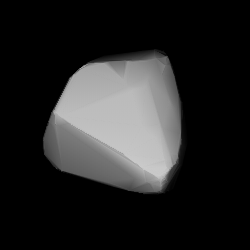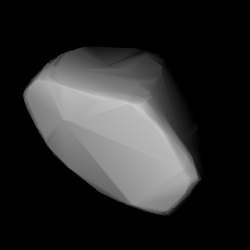Related Research Articles

Stephania is a dark background asteroid from the inner regions of the asteroid belt, approximately 32 km (20 mi) in diameter. It was discovered on 19 May 1881, by Austrian astronomer Johann Palisa at the Vienna Observatory. The C-type asteroid has a rotation period of 18.2 hours. It was named after Princess Stéphanie of Belgium.
997 Priska, provisional designation 1923 NR, is a carbonaceous Adeonian asteroid from the central regions of the asteroid belt, approximately 19 kilometers in diameter. It was discovered on 12 July 1923, by astronomer Karl Reinmuth at the Heidelberg-Königstuhl State Observatory in southwest Germany. The asteroid's name is a common German female name, unrelated to the discoverer's contemporaries.

1039 Sonneberga, provisional designation 1924 TL, is a dark background asteroid, approximately 34 kilometers in diameter, located in the central region of the asteroid belt. It was discovered on 24 November 1924, by German astronomer Max Wolf at Heidelberg Observatory in southwest Germany. The asteroid was named for the German city of Sonneberg, where the Sonneberg Observatory is located.
1031 Arctica, provisional designation 1924 RR, is a dark asteroid from the outer region of the asteroid belt, approximately 75 kilometers in diameter. It was discovered on 6 June 1924, by Soviet−Russian astronomer Sergey Belyavsky at Simeiz Observatory on the Crimean peninsula. It was named for the Arctic Sea.
1076 Viola, provisional designation 1926 TE, is a Nysian asteroid from the inner regions of the asteroid belt, approximately 22 kilometers in diameter. It was discovered on 5 October 1926, by German astronomer Karl Reinmuth at the Heidelberg Observatory in southwest Germany. The asteroid was named after the flowering plant Viola.
1156 Kira, provisional designation 1928 DA, is a stony background asteroid from the inner regions of the asteroid belt, approximately 9 kilometers in diameter. It was discovered on 22 February 1928, by German astronomer Karl Reinmuth at Heidelberg Observatory in southwest Germany. Any reference of its name to a person or occurrence is unknown.
6349 Acapulco, provisional designation 1995 CN1, is a dark Adeonian asteroid from the middle region of the asteroid belt, approximately 22 kilometers in diameter.
1783 Albitskij, provisional designation 1935 FJ, is a carbonaceous Adeonian asteroid from the middle region of the asteroid belt, approximately 22 kilometers in diameter. It was discovered on 24 March 1935, by Georgian–Russian astronomer Grigory Neujmin at the Simeiz Observatory on the Crimean peninsula. The asteroid was named after Soviet astronomer Vladimir Albitzky.
1651 Behrens, provisional designation 1936 HD, is a stony Florian asteroid from the inner regions of the asteroid belt, approximately 10 kilometers in diameter. Discovered by Marguerite Laugier in 1936, it was named after Johann Behrens.
2038 Bistro, provisional designation 1973 WF, is a stony asteroid from the inner regions of the asteroid belt, approximately 12 kilometers in diameter. The asteroid was discovered on 24 November 1973, by Swiss astronomer Paul Wild at the Zimmerwald Observatory near Bern, Switzerland. It was named for the Bistro restaurant.
1295 Deflotte, provisional designation 1933 WD, is a carbonaceous asteroid from the outer regions of the asteroid belt, approximately 48 kilometers in diameter. It was discovered on 25 November 1933, by French astronomer Louis Boyer at the Algiers Observatory in Algeria, North Africa. The asteroid was named after the discoverer's nephew.
1267 Geertruida, provisional designation 1930 HD, is a carbonaceous background asteroid from the inner regions of the asteroid belt, approximately 20 kilometers in diameter. Discovered by astronomer Hendrik van Gent at Johannesburg Observatory in 1930, the asteroid was later named after Geertruid Pels, sister of Dutch astronomer Gerrit Pels.
1309 Hyperborea is a carbonaceous background asteroid from the outermost regions of the asteroid belt, approximately 57 kilometers in diameter. It was discovered on 11 October 1931, by Soviet astronomer Grigory Neujmin at the Simeiz Observatory on the Crimean peninsula, and given the provisional designation 1931 TO. The asteroid was named after Hyperborea, the northern homeland of a Greek mythical race of giants.
1384 Kniertje, provisional designation 1934 RX, is a dark Adeonian asteroid from the central regions of the asteroid belt, approximately 26 kilometers in diameter. It was discovered on 9 September 1934, by Dutch astronomer Hendrik van Gent at the Union Observatory in Johannesburg, South Africa. The asteroid was named after a character in the Dutch play Op Hoop van Zegen by Herman Heijermans.

1361 Leuschneria, provisional designation 1935 QA, is a carbonaceous asteroid from the outer regions of the asteroid belt, approximately 30 kilometers in diameter. It was discovered on 30 August 1935, by Belgian astronomer Eugène Delporte at Uccle Observatory in Belgium, and named after American astronomer Armin Otto Leuschner.
1936 Lugano, provisional designation 1973 WD, is a carbonaceous Adeonian asteroid from the middle region of the asteroid belt, approximately 26 kilometers in diameter.
2056 Nancy, provisional designation A909 TB, is a stony background asteroid from the inner regions of the asteroid belt, approximately 10 kilometers in diameter. It was discovered on 15 October 1909, by German astronomer Joseph Helffrich at Heidelberg Observatory in southwest Germany. The S-type asteroid has a tentative rotation period of 15.0 hours. It was named for Nancy Marsden, wife of British astronomer Brian G. Marsden.

1197 Rhodesia, provisional designation 1931 LD, is a dark background asteroid from the outer regions of the asteroid belt, approximately 48 kilometers in diameter. It was discovered on 9 June 1931, by South African astronomer Cyril Jackson at the Union Observatory in Johannesburg. The likely C-type asteroid has a rotation period of 16.1 hours. It was named for Rhodesia, a former British colony and unrecognised state, which is now Zimbabwe.
1258 Sicilia, provisional designation 1932 PG, is a dark background asteroid from the outer regions of the asteroid belt, approximately 44 kilometers in diameter. It was discovered on 8 August 1932, by astronomer Karl Reinmuth at the Heidelberg-Königstuhl State Observatory in southwest Germany. The asteroid was named after the Italian island of Sicily.
1257 Móra, provisional designation 1932 PE, is an asteroid from the inner regions of the asteroid belt, approximately 15 kilometers in diameter. It was discovered on 8 August 1932, by German astronomer Karl Reinmuth at Heidelberg Observatory in southwest Germany. The asteroid was named after Hungarian astronomer Károly Móra.
References
- 1 2 3 4 "JPL Small-Body Database Browser: 1238 Predappia (1932 CA)" (2017-09-30 last obs.). Jet Propulsion Laboratory . Retrieved 27 October 2017.
- 1 2 3 Schmadel, Lutz D. (2007). "(1238) Predappia". Dictionary of Minor Planet Names. Springer Berlin Heidelberg. p. 103. doi:10.1007/978-3-540-29925-7_1239. ISBN 978-3-540-00238-3.
- 1 2 3 4 5 6 7 8 "LCDB Data for (1238) Predappia". Asteroid Lightcurve Database (LCDB). Retrieved 27 October 2017.
- 1 2 "Asteroid 1238 Predappia – Nesvorny HCM Asteroid Families V3.0". Small Bodies Data Ferret. Retrieved 26 October 2019.
- 1 2 3 4 Tedesco, E. F.; Noah, P. V.; Noah, M.; Price, S. D. (October 2004). "IRAS Minor Planet Survey V6.0". NASA Planetary Data System. 12: IRAS-A-FPA-3-RDR-IMPS-V6.0. Bibcode:2004PDSS...12.....T . Retrieved 22 October 2019.
- 1 2 3 Masiero, Joseph R.; Grav, T.; Mainzer, A. K.; Nugent, C. R.; Bauer, J. M.; Stevenson, R.; et al. (August 2014). "Main-belt Asteroids with WISE/NEOWISE: Near-infrared Albedos". The Astrophysical Journal. 791 (2): 11. arXiv: 1406.6645 . Bibcode:2014ApJ...791..121M. doi:10.1088/0004-637X/791/2/121 . Retrieved 27 October 2017.
- 1 2 3 4 Mainzer, A.; Grav, T.; Masiero, J.; Hand, E.; Bauer, J.; Tholen, D.; et al. (November 2011). "NEOWISE Studies of Spectrophotometrically Classified Asteroids: Preliminary Results". The Astrophysical Journal. 741 (2): 25. arXiv: 1109.6407 . Bibcode:2011ApJ...741...90M. doi:10.1088/0004-637X/741/2/90.
- 1 2 3 4 Nugent, C. R.; Mainzer, A.; Masiero, J.; Bauer, J.; Cutri, R. M.; Grav, T.; et al. (December 2015). "NEOWISE Reactivation Mission Year One: Preliminary Asteroid Diameters and Albedos". The Astrophysical Journal. 814 (2): 13. arXiv: 1509.02522 . Bibcode:2015ApJ...814..117N. doi:10.1088/0004-637X/814/2/117 . Retrieved 27 October 2017.
- 1 2 3 4 Usui, Fumihiko; Kuroda, Daisuke; Müller, Thomas G.; Hasegawa, Sunao; Ishiguro, Masateru; Ootsubo, Takafumi; et al. (October 2011). "Asteroid Catalog Using Akari: AKARI/IRC Mid-Infrared Asteroid Survey". Publications of the Astronomical Society of Japan. 63 (5): 1117–1138. Bibcode:2011PASJ...63.1117U. doi:10.1093/pasj/63.5.1117. (online, AcuA catalog p. 153)
- 1 2 3 4 Nugent, C. R.; Mainzer, A.; Bauer, J.; Cutri, R. M.; Kramer, E. A.; Grav, T.; et al. (September 2016). "NEOWISE Reactivation Mission Year Two: Asteroid Diameters and Albedos". The Astronomical Journal. 152 (3): 12. arXiv: 1606.08923 . Bibcode:2016AJ....152...63N. doi: 10.3847/0004-6256/152/3/63 .
- 1 2 Hayes-Gehrke, Melissa N.; Chuchuva, Dmitriy; Kumthekar, Aboli; Modica, Amanda; Higgins, Annalynn; Gmurczyk, Benjamin; et al. (October 2015). "Lightcurve Analysis for 1238 Predappia". The Minor Planet Bulletin. 42 (4): 240. Bibcode:2015MPBu...42..240H. ISSN 1052-8091 . Retrieved 27 October 2017.
- 1 2 Warner, Brian D. (September 2006). "Asteroid lightcurve analysis at the Palmer Divide Observatory - late 2005 and early 2006". The Minor Planet Bulletin. 33 (3): 58–62. Bibcode:2006MPBu...33...58W. ISSN 1052-8091 . Retrieved 27 October 2017.
- 1 2 Behrend, Raoul. "Asteroids and comets rotation curves – (1238) Predappia". Geneva Observatory . Retrieved 27 October 2017.
- ↑ Veres, Peter; Jedicke, Robert; Fitzsimmons, Alan; Denneau, Larry; Granvik, Mikael; Bolin, Bryce; et al. (November 2015). "Absolute magnitudes and slope parameters for 250,000 asteroids observed by Pan-STARRS PS1 - Preliminary results". Icarus. 261: 34–47. arXiv: 1506.00762 . Bibcode:2015Icar..261...34V. doi:10.1016/j.icarus.2015.08.007 . Retrieved 27 October 2017.
- 1 2 "1238 Predappia (1932 CA)". Minor Planet Center. Retrieved 27 October 2017.
- 1 2 Nesvorný, D.; Broz, M.; Carruba, V. (December 2014). "Identification and Dynamical Properties of Asteroid Families". Asteroids IV. pp. 297–321. arXiv: 1502.01628 . Bibcode:2015aste.book..297N. doi:10.2458/azu_uapress_9780816532131-ch016. ISBN 9780816532131.
- ↑ "Neo-Fascists In Italy Gather For 90th Anniversary Of March On Rome" by Marco Pasqua, Huffington Post , 27 October 2012
- ↑ "Inside the Mussolini Museum" by Barbie Latza Nadeau, The Daily Beast , 26 April 2015